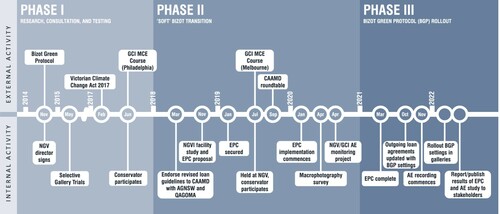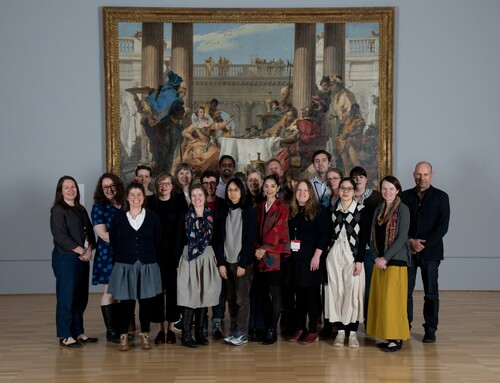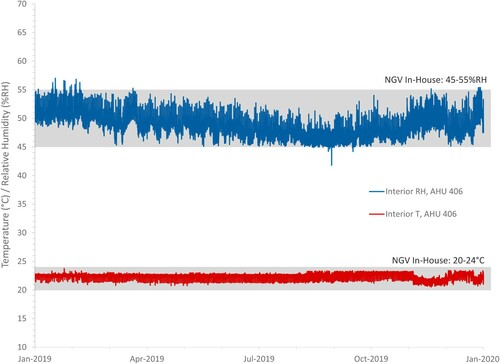ABSTRACT
Recent environmental guidance in the cultural heritage field reflects the increasingly important objectives of sustainability and reduced carbon footprint. New and revised guidance from organisations such as the Bizot Group, IIC/ICOM-CC, AICCM, and ASHRAE share common principles, including consideration of passive low-energy environmental control methods, adoption of realistic target conditions given the building envelope and exterior climate, and support for broader environmental parameters for many classes of objects. Motivated by an interest in energy savings and security, as well as broad organisational involvement and buy-in for implementing environmental change, the National Gallery of Victoria (NGV) in Melbourne, Victoria, is adopting the Bizot Green Protocol (BGP) for its collection and for outgoing loans. Initial NGV trials of a transitionary ‘soft Bizot’ setting – temperature between 20°C and 23°C with 24-hour fluctuations of no more than ±1.5°C and relative humidity between 46% and 56% with 24-hour fluctuations of no more than ±4% – demonstrated reduced energy use. The NGV and the Getty Conservation Institute are collaborating to examine object response during this environmental transition. In addition to visual monitoring of several works in the collection using macrophotography, acoustic emission (AE) monitoring will be carried out on a Flemish retable consisting of carved and polychromed wood and oil paint. AE monitoring is a highly sensitive technique that measures energy, in the form of transient elastic waves, released by and propagated through a material such as wood that has undergone brittle cracking. This has the potential benefit of detecting environmentally induced micro-changes in an object before damage is visible to the viewer.
Introduction
In 2014, the National Gallery of Victoria (NGV) Director Tony Ellwood moved to endorse the Bizot Green Protocol (BGP) along with other signatories of the Bizot Group (NMDC Citation2015). The Bizot Group, also known as The International Group of Organizers of Major Exhibitions, represents some 50 of the largest art museums globally, providing a forum to discuss museum issues and exchange ideas. The BGP was developed to ‘reconcile the desirability of long-term preservation of collections with the need to reduce energy use’ and endorses locally relevant, passive control methods as its basis. Whilst recognising that more sensitive materials may require particular environmental settings, general environmental guidelines given are a stable temperature of 16–25°C with a relative humidity (RH) of 40–60% and fluctuations of no more than ±10% RH per 24 h (NMDC Citation2015).
It is expected that member organisations have programmed, or are in the process of incorporating, the BGP settings into their building systems and loan agreements (). Few Bizot Group members have, however, published their implementation strategy or findings and reflections on the process.Footnote1 This case study aims to fill this gap.
Table 1. Range of collection and loan gallery environments currently used by NGV’s in-house and lending programmes.
The NGV consists of two public sites: the NGV-I is dedicated to the international collection and was purpose-built in the 1960s, while the NGV-A is dedicated to the exhibition of the Australian collection and opened in 2008. Melbourne is located within a temperate climate zone, designated ‘Climate Zone 3A (Warm Humid)’ as defined by the ASHRAE 169-2020 standard (ASHRAE Citation2020) and Köppen classification Cfb (Oceanic Climate), with average annual daytime temperatures of 15–25°C.
Covering 17,000 m2 of exhibition space, the NGV-I building is clad with blue stone that provides a skin of high thermal mass. Internally, 35 of its 71 air handling units (AHUs) service 30 galleries designed to be sealable spaces with independent environmental control. In 2011 controlled evening shut-down testing of the heating, ventilation and air conditioning (HVAC) system was carried out and demonstrated the capacity of the closed building to hold conditions with minimal change to temperature and relative humidity from 7 pm to 7 am across summer and winter periods. Due to its high level of environmental performance and control, the NGV-I was the first of the two NGV sites considered for the BGP project.
The response of objects to the broader BGP temperature and RH conditions, particularly those thought to be vulnerable to environmental change, needed to be monitored and understood. The NGV holds an encyclopaedic collection of over 83,000 Australian and international objects. In common with many collections, wood is the most prevalent of the hygroscopic materials present. It occurs in almost every collection area sculpture and period including frames, furniture, decorative arts, Aboriginal art, and painting supports and stretchers. The response of wooden objects is being documented through the BGP transition and full implementation using acoustic emission (AE) monitoring in partnership with the Getty Conservation institute (GCI). A fifteenth-century Flemish retable made of carved wood with gilding and polychromy was chosen as the object of the AE study for its material composition, well-documented condition and treatment history, and gallery location. This study is supported by simple documentation tools used by the NGV for other collection objects.
The process of revising the environmental settings for collection and loan works requires technical, behavioural and procedural change. There are a range of resources specifically designed to support museums and galleries to assess, develop and coordinate their activities across teams, allowing them to implement museum-specific environmental parameters based on the local climate, infrastructure, collections and resources, including staff (Ankersmit and Stappers Citation2017; ASHRAE Citation2019). More broadly, organisational change models begin with creating an awareness of the need and desirability for change; the removal of barriers to change; and the strengthening of knowledge, skills and communication to institute the change.
This paper deals with the initial motivations for facilitating the transition to the BGP and how points of resistance and practical difficulties were addressed in the lead up to, and as part of, the implementation process. This implementation is still in progress but can be categorised into three phases: research, consultation and testing (phase I); ‘soft Bizot’ transition (phase II); and BGP roll-out (phase III) (). This paper will focus on phases I and II of the project with the intention that the results of phase III, including energy savings and the results of the AE testing, will be presented at project completion.
Motivations and counter motivations to implement the BGP
Following the Bizot Group’s adoption of the BGP a meeting was held between the NGV Director and the NGV Head of Conservation. They agreed that a staged pathway, incorporating a series of phases, would be the preferred way of implementing changes to environmental parameters at the NGV-I site.
This directive coincided with a period of rising utility costs, government-led energy efficiency measures through the Greener Government Buildings programme (Victoria State Government Citation2018) and state-wide power grid instability. In 2017 the Victorian Climate Change Act 2017 mandated a net zero emissions target by 2050 to reduce emissions from state government operations including the NGV (Victoria State Government Citation2021). Given that the energy costs associated with running the HVAC system account for over 60% of electricity consumption, the NGV facilities team, who are responsible for utilities expenditure and efficiency reporting, were keen to explore initiatives that would contribute to more efficient use of existing infrastructure while maintaining visitor comfort levels and avoiding change and damage to artworks.
Across the conservation and registration departments, support and interest in the implementation of the BGP varied. Amongst a staff of over 20 conservators, there was a mix of what has been described as ‘precautionary safety’ and ‘proven safety’ risk stances towards risk management of the collection (Boersma, Dardes, and Druzik Citation2014). Collection conservators and registrars tended to seek out the safety margins afforded by standard set-points and held a preference for what was seen to be industry ‘best practice’ (Henderson Citation2018, 36). In addition, they raised questions about whether the gains in financial savings and reduced carbon footprint warranted the potential risk of change to collection material and were concerned about the additional resourcing that would be required to evaluate and monitor these changes during the implementation, and longer-term operation of changed settings.
Exhibition conservation staff, who deal primarily with incoming loaned artworks, tended towards what has been described as a ‘proven safety’ and ‘pragmatic risk’ approach (Boersma, Dardes, and Druzik Citation2014). These conservators were conversant with the wide variability of environmental conditions outlined in loan agreements between Australian and international lenders and the range of climates and conditions from which loan works originate (these have included gardens and domestic bathrooms) for exhibition in ‘ideal’ conditions. They have been strong advocates for more flexible parameters to promote lending to regional galleries, as reflected in the NGV outgoing loan environmental specifications ().
Phase I: research, consultation, and testing
Following executive endorsement of the BGP, there was a period of information gathering to research and review current literature on developments in the field, prioritising professional development training in this area (including attendance at the 2017 and 2019 Managing Collection Environments Preserving collections in the age of sustainability courses developed by the GCI) (), consulting with colleagues and project stakeholders and consideration of the impacts of this change across all collections, loan programmes and operational workflows.
Software system updates
Briefing sessions and ongoing project meetings were set up between collection care, facilities and engineering staff in order to share information about the assumptions, expectations and needs for HVAC system operation. Understanding what settings were being used across loan and collection environments and how input settings performed within individual gallery spaces was critical. It was clear that a distinction could be drawn between stated settings and settings in use, where the stated settings refer to the parameters used in documentation such as policies, procedures and loan agreements, while the settings in use describe the control settings for the software system and building performance.
NGV facilities and engineering staff worked with the contractors responsible for the NGV-I HVAC system to commission an adaptive ‘soft Bizot’ control strategy for temperature and RH using the existing mechanical system across gallery and art storage areas and a zero-band setting for non-exhibition areas (). The ‘soft Bizot’ control strategy focused on increasing efficiency within the building automation system (BAS) by shifting from a set-point strategy, where the BAS corrects to a single temperature, to a setting that allowed the gallery conditions to drift between 20°C and 23°C and 46–54% RH with no more than ±1.5°C or 4% RH change within 24 h.
Re-evaluating a shared culture of collection care
Fostering collegial and frank discussions on the likelihood and acceptability of change to collection and loan works caused by fluctuations in gallery environments was critical to managing the varied levels of knowledge, experience and interest within the NGV departments (Ankersmit and Stappers Citation2017; Henry and Jessup Citation2018). Departmental presentations addressing industry developments on environmental settings for collections and ongoing conversations on an artwork-by-artwork and gallery-by-gallery basis have helped to move the internal position from risk avoidance to pragmatic risk management. Also critical was reiterating the complex environmental response, preservation strategies and change or damage values that we currently apply across different collection types and conservation activities. For example, specialist storage environments are in place for sensitive material types (low RH for weeping glass and archaeological bronze storage) and freezing is used as an option for pest treatment. Conservators actively manage the risk of moving works across differing temperature and RH levels.
Phase II: ‘soft Bizot’ transition
Following the positive outcomes of the selective gallery trial – and building on a growing interest in evaluating the impacts and efficiency outcomes of the project – the next phase focused on securing funding for the roll-out of mechanical upgrades for the ‘soft Bizot’ implementation. At the same time, engagement continued with industry stakeholders for support of broader adoption of wider environmental settings and continued technical research to assess the impacts of ‘full’ BGP parameters on sensitive collection materials.
Implementation of ‘soft Bizot’
Securing funding for the systems’ upgrades was critical to progress the technical implementation. In 2019 the NGV entered an energy performance contract (EPC) through the Victorian State Government’s Green Government Buildings programme. This programme provides government loans and rebates to install energy efficient measures within a five-year payback period. The NGV contract included upgrades to lighting and water management, installation of solar panels and building improvements for the NGV-I HVAC system. The latter included replacing the existing air filters with ionised oxygen units, upgrading the heated/chilled water pump valves and switching from fixed environmental set-points to dead band ranges. ‘Soft Bizot’ settings were programmed for the BAS ready for a staged rollout in the galleries. These upgrades were completed by March 2020.
To track the response of collection objects to the revised settings, the conservation department teamed with NGV Photographic Services to use traditional methods of observational condition reports, measurements and macrophotography to survey existing cracking in works within these galleries deemed to be sensitive to change; for example, marquetry furniture. In April 2020, the collaborative study with GCI to use AE monitoring in a gallery was confirmed. Subsequent travel restrictions and intermittent closure of both institutions due to Covid-19 restrictions delayed the initiation of the project until 2021.
With the NGV galleries closed and isolated during lockdowns, a unique opportunity presented itself to roll out testing of the ‘soft Bizot’ parameters in the dedicated collection spaces (except for the gallery where AE was to be installed) in a more controlled manner. This began systematically, one level at a time, starting with mid-level galleries buffered by floors above and below. Additional environmental data loggers were installed next to collection items.
Loan programme stakeholders’ consultation and information sharing
In September 2018, in a meeting of the Heads of Conservation from Queensland Art Gallery and Museum of Art (QAGOMA), Art Gallery of New South Wales (AGNSW) and NGV, it was agreed that the BGP and the nationally-developed Australian Institute for the Conservation of Cultural Materials environmental guidelines (AICCM Citation2018) would be adopted for collections and loans. This was later submitted to, and approved by, the Council of Australasian Art Museum Directors (CAAMD) meeting held at the NGV.
A one-day roundtable inviting facilities, registration, conservation and collection management staff from CAAMD members was hosted by the NGV in late 2019 to facilitate open dialogue on: what parameters members were setting and achieving across their exhibition and storage areas; whether options for widening environmental parameters had been implemented or considered; what issues members had to address to be able to implement these changes; and the sharing of relevant case studies. The roundtable was a useful forum in which to exchange ideas, review requisite amendments to loan documentation and identify areas in which resources and future research might be shared.
During this period, the NGV hosted the second iteration of the two-week workshop component of the GCI Managing Collection Environments course, which had an important influence on the NGV’s decision-making process and planted the seed for collaborative AE testing at the NGV ().
AE monitoring and cultural heritage
Maintaining high standards of collection care while considering broader climatic ranges relies on a scientific understanding of object response to these conditions. A technique that can contribute to this understanding is AE monitoring, a highly sensitive, non-destructive method capable of detecting micro-damages in objects that result from changes to RH and temperature. The brittle cracking of material triggers the release of energy in the form of elastic waves that propagate through the material. This acoustic emission can be detected by piezoelectric sensors positioned at the object surface (Łukomski et al. Citation2020).
Long used in industrial applications for structural health monitoring and quality control, AE monitoring has more recently been applied to cultural heritage objects and is particularly appropriate to assess the response of wooden artefacts to their environment. Being hygroscopic, wood is subject to brittle cracking events caused by dimensional changes in response to variations in environmental conditions, predominantly RH (Mecklenburg, Tumosa, and Erhardt Citation1998; Bratasz Citation2013). AE monitoring can detect these cracking events in real time and these data can be analysed in relation to concurrent environmental readings.
The technique was first applied to wooden artworks in 2007 on a limewood polychrome sculpture, in order to trace AE activity during heating events in the church that housed the object (Jakieła, Bratasz, and Kozłowski Citation2007). Subsequently, AE monitoring has been used to characterise stress responses in wood while assessing climate management strategies (Strojecki et al. Citation2014; Łukomski et al. Citation2017). In response to growing interest in the technique for cultural heritage applications, the GCI convened a meeting of experts on AE monitoring in 2017 to discuss the state of the field, resulting in the publication of guidelines for applications and methodologies, Acoustic Emission Monitoring for Cultural Heritage (Łukomski et al. Citation2020).
In situ AE monitoring at the National Gallery of Victoria
To assess object response during the implementation of the NGV’s new climate strategy, the GCI and the NGV are collaborating in the use of AE monitoring to study a Flemish carved wooden retable of The Passion of Christ, c. 1510–1520 (3660-D3) in situ during the transition of the gallery space to ‘full’ BGP parameters (). Ongoing restrictions in travel during 2020–2021 meant that GCI staff were not able to visit the NGV and they made the generous decision to send the AE equipment and continue the project through remote collaboration (). Following a planning and design phase, the study was ready to begin. Working around exhibition schedules and delays due to NGV closures, AE recording commenced in November 2021.
Figure 3. Gallery display of the retable with AE monitoring installed (top) with customised sensor mounts for the back of the retable (bottom left) and the back of a sculpture carved in high relief (bottom right).
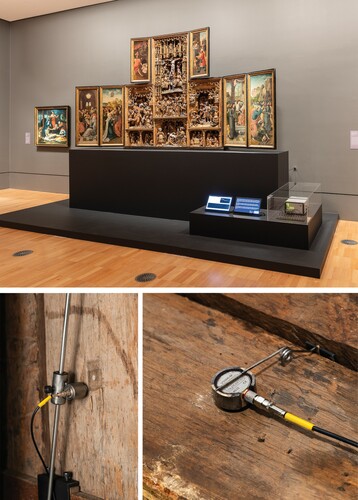
Figure 4. Testing of the AE setup carried by NGV staff under remote direction from the GCI Science team by video conference.
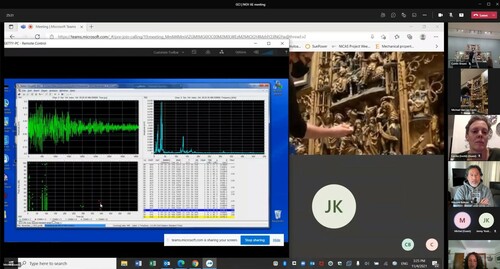
The retable has been on display in its current location since 2003. This gallery was not included in the ‘soft Bizot’ rollout in order to collect baseline AE data under the pre-existing NGV in-house environmental conditions. Once the baseline data collection is complete, the climate parameters in this single gallery will be widened to the full BGP ( and ). AE monitoring is ongoing and will continue at the new settings for 12 months to include seasonal variation. The data before and after the transition of environmental conditions will then be analysed to determine any change in object response that could indicate increased damage.
The Flemish retable
The retable was produced in or near Antwerp in 1510–1520 and would have been placed at the high altar of a Catholic church for the edification of, and veneration by, the faithful. Its construction and format are typical of the Guild of Antwerp’s workshop production at the time (Jacobs Citation1998). It consists of a wooden case constructed of solid oak planks that houses 103 polychromed and gilded oak sculptures that form multi-figured scenes of the Passion of Christ. Four hinged panel painting ‘wings’ attached to the case are typically displayed open. In total, the work is 4.01 m wide and 2.02 m high.
Several factors made the retable an ideal subject for this study. It is displayed in a gallery space with a dedicated AHU, separated from other galleries by a single door and interstitial spaces so that its climate can be controlled in isolation from other parts of the building. The retable is representative of wood-containing objects in this part of the collection and contains a variety of wooden elements, including small gilded and painted sculptures and the large uncoated planks of the case (the panel paintings of the shutters were not used as they have been marouflaged to plywood). It has been on display in this gallery since 2003, and its treatment history is well-documented and understood, including a major treatment in 1982–1983. Its large size and display on a plinth allow the monitoring equipment to be installed in a visually unobtrusive manner with limited potential for unwanted visitor interaction.
Equipment and data collection
The AE data are being collected using an AMSY-6 multi-channel AE measurement system (Vallen Systeme GmbH, Germany) described by Łukomski et al. (Citation2017), following the measurement protocols and data analysis methods outlined by Łukomski et al. (Citation2020). The components include: six AE sensors (wide band PCA WD, Vallen Systeme, and point contact KRNBB-PC, KRN Services) and corresponding preamplifiers, an RH/temperature probe, the main chassis housing the signal processors and a laptop to run software for data acquisition and analysis. BAS energy consumption data and both gallery and external environmental data (RH and temperature) will be collected throughout the AE monitoring period.
Installation and display
Data quality and object safety were the primary considerations when selecting locations to mount the sensors. The sensors also had to be accessible while on display to perform regular testing of their connectivity. Three sensors were attached to the large oak planks forming the back of the case, positioned at the end points of existing splits as these were areas likely to experience microcracking. Three sensors were placed on sculptures housed in the case, again at the end points of existing splits.
The sensor mounts were designed to present minimal risk of damage to the object, to be visually unobtrusive and to be stable over prolonged periods to avoid detachment or slippage of the sensor (). All the mounts hold the sensors in place mechanically using custom-made clamps and springs fitted to nearby elements to create positive pressure. Where required, moulds were made to create a bespoke fit that prevented movement. No adhesives were used. The mounts were made by the NGV conservation mount makers in consultation with conservators.
This study has been presented to the public in a way that invites exploration of the research without detracting from the visual experience of the retable and other objects in the gallery. The main AE controller and two digital displays are placed on the plinth to one side. One monitor shows live AE data and an accompanying screen introduces the collaborative study between the GCI and NGV, inviting visitors to explore the research further at a newly-launched microsite on the NGV website dedicated to conservation, sustainability and the NGV gallery environment.
The setup has performed well since recording commenced in November 2021. Most of the typical sounds generated in the gallery, including visitor footfall and voices, are outside the frequency range captured and do not interfere with the monitoring. At the time of writing, baseline data were still being collected. The object response is not expected to change following the transition to the new BGP conditions (Michalski Citation2007; Łukomski et al. Citation2018), but full results from the study will be presented once recording is complete.
Phase III: BGP roll out
In 2021, the NGV updated its outgoing loan agreements to reflect the BGP settings. This change requires specialist conservators to examine more closely the history of each borrowing institution’s gallery environment, its environmental monitoring programme and its exhibition design plans. It also requires more time for the preparation of sensitive works for display.
In 2022, the gallery dedicated to the AE study will transition to full BGP, with the remaining collection galleries maintained at ‘soft Bizot’ settings. A continued programme of observational surveying with measurement and macrophotographic comparisons will be complemented by the higher resolution of AE analysis to define object response to the revised settings empirically. These data and information on the specific response of the NGV-I building, the HVAC system, the expanded expertise of staff, and other potential limiting factors such as human comfort, will be used to make informed decisions around rolling out BGP throughout the building. Due to lender specifications, the loan exhibition spaces remain at traditional parameters but can be changed as opportunities arise.
A similar model of testing and roll-out is also planned for the NGV-A site. This presents different circumstances and new challenges; it is a materially different building, leased from a separate government entity that operates and maintains the HVAC system. But the lessons learned from the implementation of revised settings at NGV-I will serve this next undertaking well. The current collaborative project between the GCI and NGV will be vital in preparing for this programme, but should also support industry change more broadly through dissemination of data and outcomes from the current project.
Conclusion
The recommendation to move towards, and subsequent inertia in implementing, institutionally- or locally-defined environmental guidelines is widely documented (Ashley-Smith, Umney, and Ford Citation1994; Michalski Citation2011; Kirby Atkinson Citation2014; Staniforth Citation2014; Henderson Citation2018). The overemphasis on ‘best practice’ industry standard settings of 50 ± 5% RH and 21 ± 2°C has been the focus of professional debate for over two decades. Beginning in 2014, leading professional bodies such as the IIC, ICOM-CC and AICCM revised their recommended environmental standards to move away from the use of prescriptive settings.
For the NGV, clear executive direction coupled with government environmental sustainability initiatives and financial support have been strong motivators to investigate and adopt adaptable environmental parameters for collection and loan works in our galleries. Ensuring dialogue amongst key internal staff from across facilities, registration and conservation departments – as well as other stakeholders, such as their counterparts in loaning institutions – has been key to ensuring that knowledge and professional insights are shared, and stakeholder concerns are openly evaluated and managed. This includes the impacts of changed environmental settings on the state collection. Through joint research with the GCI into monitoring the effects of widening the environmental settings in our collection galleries to the BPG, along with supplementary in-house observational monitoring, we are using an evidence-based strategy to measure impacts to collections that can be correlated against future energy efficiency gains.
Acknowledgements
The authors would like to acknowledge the ongoing cooperation of NGV colleagues Tony Ellwood (Director), Tony Henshaw (Manager, Facilities), Gilles Bonnet (Building Engineer), Lucy Hastewell (Associate Director, Facilities and Operations), Catherine Earley (Senior Conservator for Exhibitions), Paula Nason (Head of Registration) and Ieva Kanepe (Senior Registrar, Loans) in implementing the BGP at the NGV. Also, Tim Whalen (GCI Director), Tom Learner (GCI Head of Science) and former GCI colleagues Kathleen Dardes, Foekje Boersma, Joel Taylor and Annelies Cosaert for their support in facilitating this research partnership.
Disclosure statement
No potential conflict of interest was reported by the author(s).
Notes
1 For example, Tate’s endorsement of the BGP is publicised on its website, and the Art Gallery of New South Wales mentions implementation of the BGP in its 2019–2020 Annual Report.
References
- AICCM. 2018. Environmental Guidelines. Australian Institute for the Conservation of Cultural Material. Accessed 2 May 2022. https://aiccm.org.au/conservation/environmental-guidelines/.
- Ankersmit, B., and M. H. L. Stappers. 2017. Managing Indoor Climate Risks in Museums. Cham: Springer.
- Ashley-Smith, J., N. Umney, and D. Ford. 1994. “Let’s Be Honest — Realistic Environmental Parameters for Loaned Objects.” Studies in Conservation 39 (sup2): 28–31.
- ASHRAE. 2019. “Museums, Galleries, Archives and Libraries.” Atlanta: ASHRAE.
- ASHRAE. 2020. ANSI/ASHRAE Standard 169-2020 Climatic Data for Building Design Standards. Atlanta: ASHRAE.
- Boersma, F., K. Dardes, and J. Druzik. 2014. “Precaution, Proof and Pragmatism: Evolving Perspectives on the Museum Environment.” In Conservation Perspectives, 4–9. Los Angeles: Getty Conservation Institute.
- Bratasz, Ł. 2013. “Allowable Microclimatic Variations for Painted Wood.” Studies in Conservation 58 (2): 65–79.
- Henderson, J. 2018. “Reflections on the Psychological Basis for Suboptimal Environmental Practices in Conservation.” Journal of the Institute of Conservation 41 (1): 32–45.
- Henry, M. C., and W. C. Jessup. 2018. “From the Outside in: A Collaborative Approach to Context-Driven and Capacity-Constrained Preventive Conservation Strategies for Collections in Heritage Buildings and Sites.” Studies in Conservation 63 (sup1): 121–126.
- Jacobs, L. F. 1998. Early Netherlandish Carved Altarpieces, 1380–1550: Medieval Tastes and Mass Marketing. Cambridge: Cambridge University Press.
- Jakieła, S., Ł Bratasz, and R. Kozłowski. 2007. “Acoustic Emission for Tracing the Evolution of Damage in Wooden Objects.” Studies in Conservation 52 (2): 101–109.
- Kirby Atkinson, J. 2014. “Environmental Conditions for the Safeguarding of Collections: A Background to the Current Debate on the Control of Relative Humidity and Temperature.” Studies in Conservation 59 (4): 205–212.
- Łukomski, M., V. Beltran, F. Boersma, J. Druzik, A. Freeman, M. Strojecki, T. Learner, and J. Taylor. 2018. “Monitoring Acoustic Emission in an Epidemiological Pilot Study of a Collection of Wooden Objects.” Studies in Conservation 63 (sup1): 181–186.
- Łukomski, M., Ł Bratasz, E. Hagan, M. Strojecki, and V. L. Beltran. 2020. Acoustic Emission Monitoring for Cultural Heritage. Los Angeles: Getty Conservation Institute. Accessed May 2, 2022. http://hdl.handle.net/10020/gci_pubs/acoustic_emission.
- Łukomski, M., M. Strojecki, B. Pretzel, N. Blades, V. L. Beltran, and A. Freeman. 2017. “Acoustic Emission Monitoring of Micro-damage in Wooden Art Objects to Assess Climate Management Strategies.” Insight - Non-Destructive Testing and Condition Monitoring 59 (5): 256–264.
- Mecklenburg, M. F., C. S. Tumosa, and D. Erhardt. 1998. “Structural Response of Painted Wood Surfaces to Changes in Ambient Relative Humidity.” In Painted Wood: History and Conservation, edited by V. Dorge, and F. C. Howlett, 464–483. Los Angeles: Getty Conservation Institute.
- Michalski, S. 2007. “The Ideal Climate, Risk Management, the ASHRAE Chapter, Proofed Fluctuations, and Toward a Full Risk Analysis Model.” Contribution to the Experts’ Roundtable on Sustainable Climate Management Strategies, April 2007, Tenerife, Spain. Accessed May 2, 2022. http://www.getty.edu/conservation/our_projects/science/climate/paper_michalski.pdf.
- Michalski, S. 2011. “Museum Climate and Global Climate: Doing the Right Thing for Both.” Reflections on Conservation (CCI Newsletter 2011), 9–11.
- NMDC. 2015. Bizot Green Protocol.” In Environmental Sustainability: Reducing Museums’ Carbon Footprint. National Museum Directors’ Council. Accessed May 2, 2022. www.nationalmuseums.org.uk/what-we-do/contributing-sector/environmental-conditions/.
- Staniforth, S. 2014. “Environmental Conditions for the Safeguarding of Collections: Future Trends.” Studies in Conservation 59 (4): 213–217.
- Strojecki, M., M. Łukomski, L. Krzemień, J. Sobczyk, and Ł Bratasz. 2014. “Acoustic Emission Monitoring of an Eighteenth-century Wardrobe to Support a Strategy for Indoor Climate Management.” Studies in Conservation 59 (4): 225–232.
- Victoria State Government. 2018. “Greener Government Buildings.” Department of Treasury and Finance. Accessed May 2, 2022. www.dtf.vic.gov.au/funds-programs-and-policies/greener-government-buildings.
- Victoria State Government. 2021. “Climate Change Act 2017.” Accessed May 2, 2022. www.climatechange.vic.gov.au/legislation/climate-change-act-2017.

